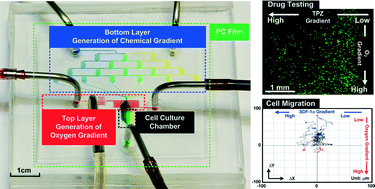A polydimethylsiloxane–polycarbonate hybrid microfluidic device capable of generating perpendicular chemical and oxygen gradients for cell culture studies†
Abstract
This paper reports a polydimethylsiloxane–polycarbonate (PDMS–PC) hybrid microfluidic device capable of performing cell culture under combinations of chemical and oxygen gradients. The microfluidic device is constructed of two PDMS layers with microfluidic channel patterns separated by a thin PDMS membrane. The top layer contains an embedded PC film and a serpentine channel for a spatially confined oxygen scavenging chemical reaction to generate an oxygen gradient in the bottom layer for cell culture. Using the chemical reaction method, the device can be operated with a small amount of chemicals, without bulky gas cylinders and sophisticated flow control schemes. Furthermore, it can be directly used in conventional incubators with syringe pumps to simplify the system setup. The bottom layer contains arrangements of serpentine channels for chemical gradient generation and a cell culture chamber in the downstream. The generated chemical and oxygen gradients are experimentally characterized using a fluorescein solution and an oxygen-sensitive fluorescent dye, respectively. For demonstration, a 48 hour cell-based drug test and a cell migration assay using human lung adenocarcinoma epithelial cells (A549) are conducted under various combinations of the chemical and oxygen gradients in the experiments. The drug testing results show an increase in A549 cell apoptosis due to the hypoxia-activated cytotoxicity of tirapazamine (TPZ) and also suggest great cell compatibility and gradient controllability of the device. In addition, the A549 cell migration assay results demonstrate an aerotactic behavior of the A549 cells and suggest that the oxygen gradient plays an essential role in guiding cell migration. The migration results, under combinations of chemokine and oxygen gradients, cannot be simply superposed with single gradient results. The device is promising to advance the control of in vitro microenvironments, to better study cellular responses under various physiological conditions for biomedical applications.


 Please wait while we load your content...
Please wait while we load your content...